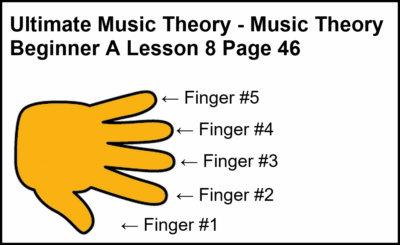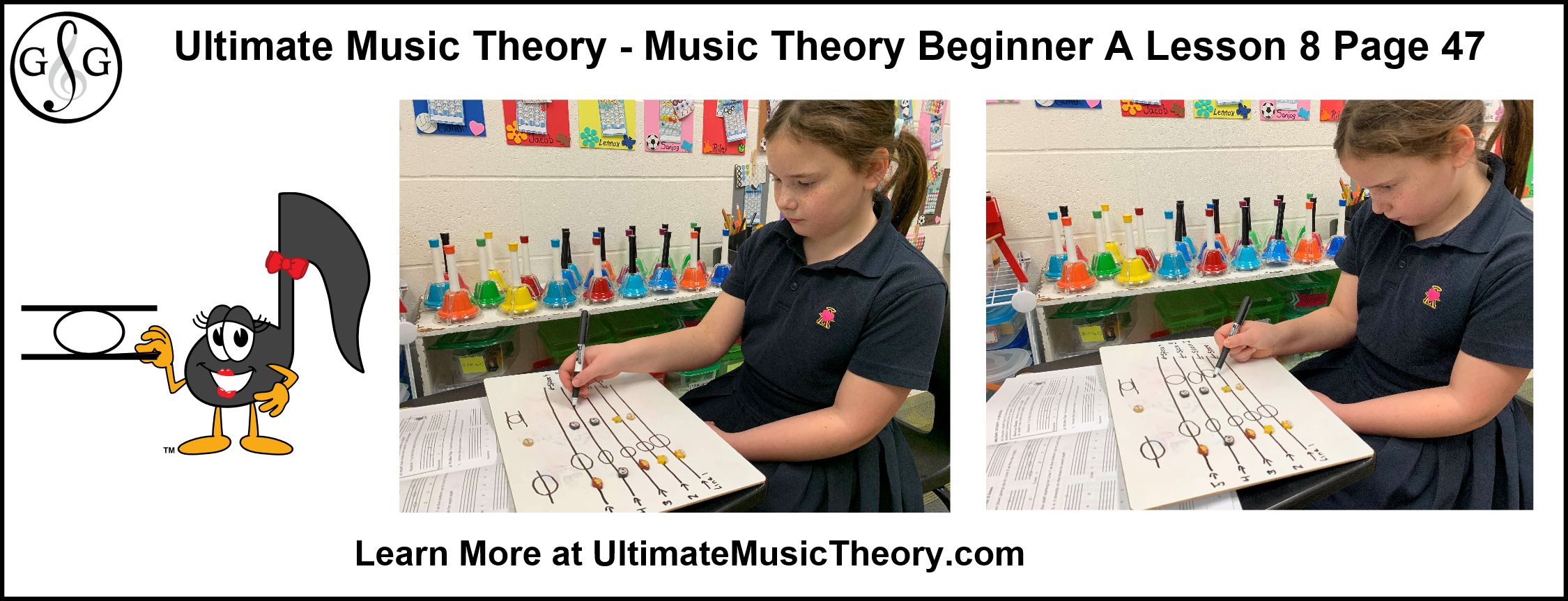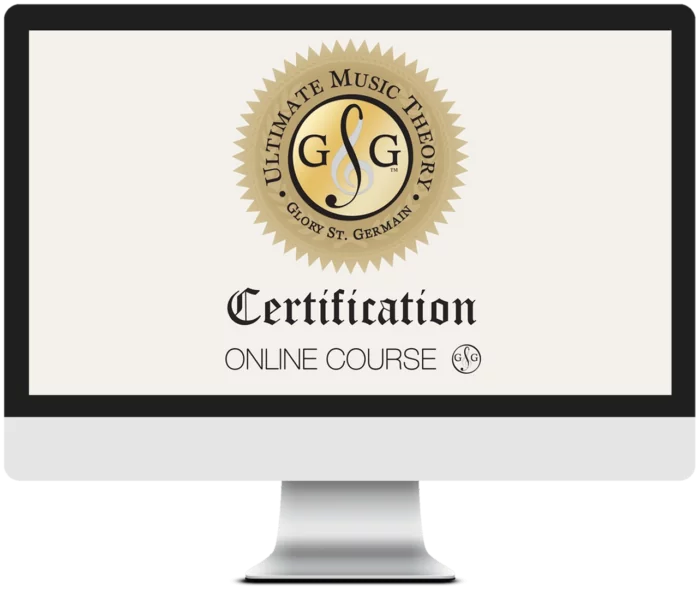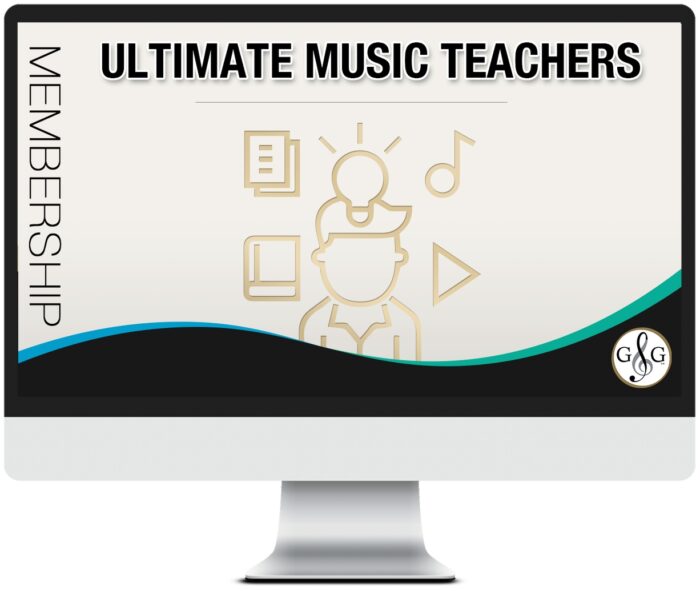How to Teach Music Theory Beginner A Lesson 8

Welcome to the How to Teach Ultimate Music Theory Beginner A Workbook Series - Lesson 8.
The Ultimate Music Theory Beginner A, B and C Workbook Series is the perfect theory supplement for Beginner Students (ALL ages, ANY instrument). The UMT Beginner A, B, C Series works with every Method Series and with every Learning Style.
In this Blog, we will look at how to teach the concepts in the Music Theory Beginner A Workbook Lesson 8. Remember to read the first 8 Blogs in this series:
Music Theory Beginner A Overview
Music Theory Beginner A - Lesson 1
Music Theory Beginner A - Lesson 2
Music Theory Beginner A - Lesson 3
Music Theory Beginner A - Lesson 4
Music Theory Beginner A - Lesson 5
Music Theory Beginner A - Lesson 6
Music Theory Beginner A - Lesson 7
Join me as we explore tips and tricks to incorporate theory, ear training, sight reading and games into every lesson. Let's jump in!
How to Teach Music Theory Beginner A Page 46
Lesson 8 introduces the Staff. A Staff has 5 lines (and 4 spaces). It is very important to count the lines from the bottom to the top.
Remind your Student that we always count UP from the bottom/lowest to the top/highest!
To reinforce this concept, have your student hold their hand in the air with their thumb at the bottom. Now count your fingers up from Finger #1 (your thumb).
Our 5 fingers are just like the 5 lines of the Staff!

You can then introduce the concept of counting UP the spaces by exploring how their is a "space" between each of their fingers. (Yes, there is a space below Finger #1 and a space above Finger #5, but we are going to keep this simple and only count the spaces between our fingers.)

A Line Note Grabs ON TO the Line!
When I was younger, I remember struggling with the concept of writing a note "ON" a line. To my undiagnosed learning challenged mind, if I put a note on a line, then the note would sit on top of the line - just like if I put my glass ON the table, the glass would sit on top of the table. Can you see how the concept of writing a note "ON" a line would be confusing (especially when my Teacher told me that "writing a note on a line" meant putting the line through the middle of the note)? *SIGH*
Now, I teach that a line note grabs on to the line! The line must run through the middle of the notehead for it to be written "on a line". (It doesn't sit on a line - it grabs on to the line.)
To help students understand this confusing concept, use your UMT Whiteboard and draw a large staff. (On the UMT Whiteboard, use the blank side to draw a large staff. If you do not have a UMT Whiteboard, then use a piece of blank paper.) Order your UMT Whiteboard today.
Have your Student:
- Number each Staff line #1 up to #5. (Remember to start at the bottom and count up!)
- From your stash of erasers, place a different eraser on each line, from Staff line #1 up to #5.
- Draw a whole note that is grabbing on to each line. Check - is the line running through the middle of the whole note?

Pop Quiz - Correct or Incorrect?
Let's have a little Pop Quiz here. Identify each of the following Line Notes as Correct or Incorrect?
Remember, to be Correct, the line must go through the middle of the notehead. Half of the notehead will be above the line and the other half will be below the line. When writing a whole note, we do not need to do that fancy shading (we are not computers). We just have to write an oval shape (one of my students calls this a "flat circle", and that actually makes sense to me!).

Here are the answers:
- Correct
- Incorrect
- Incorrect
- Incorrect
Can you explain why #2, #3 and #4 are incorrect? (If so, write your explanation in the comment section!)

A Space Note SITS IN the Space (sits in the space between 2 lines)
When a note is written IN the space, it is sitting in the space between 2 lines. Remember, right now we are not introducing the note that can be written in the space below the staff or in the space above the staff. We are just looking at the notes within the lines and spaces of the staff.
Just like we did with the line notes, let's grab our whiteboard or blank paper and draw a big staff on it.
Have your Student:
- Number each Staff space #1 up to #4. (Remember to start at the bottom and count up!)
- From your stash of erasers, place a different eraser in each space, from Staff space #1 up to #4.
- Draw a whole note that is sitting in each space (sitting inside each space). Check - is there a line at the top and at the bottom of the whole note?
Yes, the little erasers will probably not fit properly in each space, but your student will get the idea of the space that is created in between any 2 lines.

Pop Quiz - Correct or Incorrect?
Let's have another little Pop Quiz. Identify each of the following Space Notes as Correct or Incorrect.
Remember, to be Correct, the notehead must not go past the lines - it sits in that space (in between the 2 lines).
Younger students might not draw their whole notes perfectly correctly, and sometimes it is okay to be "close enough". Some children (and some adults) struggle with their fine-motor skills and it is hard for them! When I'm marking Theory, I always take into account the fine-motor skills of each student. But there is definitely a difference between being "incorrect" and being "close enough".

The answers are:
- Correct
- Incorrect
- Incorrect
- Incorrect
Let me know in the comments sections why I marked #2, #3 and #4 as incorrect.
Optional Game Ideas!
Before my Students complete Pages 48 & 49, I like to add a couple of games.
Game Idea #1 - Grab your container of erasers! Place them on different lines and spaces on the UMT Whiteboard Staff. (If you don't have a Whiteboard, draw a staff on a blank piece of paper.) Have your student identify whether each eraser is grabbing on to a Line ("L") or is sitting in a Space ("S").
You can take this to another level by asking the student to identify the Line Number or the Space Number. For example, "L2" would mean that the eraser is on Line #2; "S4" would indicate Space #4.
Game Idea #2 - On the UMT Whiteboard Staff (or on any blank staff), draw notes on different lines and spaces. Have your student identify whether each whole note is grabbing on to a Line ("L") or is sitting in a Space ("S").
Then have them identify the Line Number or the Space Number.
You can also do each of these games in reverse! Write where you would like the student to place the eraser (or draw the whole note) using "L" or "S" and the number (#1 - #5 for lines, and #1 - #4 for spaces).

Lesson 8 Review with So-La & Ti-Do
These 2 pages (pages 50 and 51) can be assigned as Homework (to be completed at home) or they can be completed at the Lesson.
Do you notice how we are also reviewing the white keys on the keyboard, and steps and skips. This type of review is very important, especially for younger students.
With a Smile and a Song,
Shelagh McKibbon-U'Ren
The Ultimate Music Theory Workbook Series - Beginner A, B, C, Prep 1, Prep 2, Basic, Intermediate, Advanced and Complete all-in-one Rudiments!

The UMT Workbooks include 12 Lessons & Review Tests, Music Theory Guide & Chart and 80 Flashcards in each workbook.
- 12 COMPREHENSIVE LESSONS - Simplify complex concepts
- GUIDE and CHART - Memory Joggers for fast and easy reference
- 12 REVIEW TESTS - Accumulative study including final exam
Ultimate Music Theory helps students prepare for nationally recognized theory exams, including the Royal Conservatory of Music Exams.
A Proven Step-by-Step Workbook System!
- LEARN FASTER – Use on any device, phone, tablet, computer
- EXPLORE – Identify written & audio notation
- PLAY – Sight Reading and Ear Training Games and much More!
Students will LOVE the UMT Flashcard System (App powered by Brainscape) that correlates to each lesson in the Beginner A, B, C, Prep 1, Prep 2, Basic, Intermediate & Advanced Workbooks.
Have fun building a foundation in Music Theory, Ear Training, and Sight Reading.
The One and ONLY Music Theory App & Matching Workbook!
Get Access To UMT Worksheets, Games, Activities, Posters, Certificates, Courses, Coaching Calls, Community & More!
Ultimate Music Teachers Membership
♪ LEARN ♪ PLAN ♪ TEACH ♪ GROW
The One & ONLY Ultimate Music Teachers Membership
To Become A UMT PRO!
Your Success Path Starts Here - Go To TeachUMT.com Today!

Ultimate Music Theory Certification Elite Educator Program - Online Teacher Training to Elevate Your Income, Impact Your Teaching and Grow Your Expert Music Teaching Business. Get Certified!
Click HERE to discover what you will learn in the Ultimate Music Theory Certification Course. Your professional development Online Teacher Training starts here!
Keep on Learning... With a Smile and a Song!
Shelagh McKibbon-U'Ren



